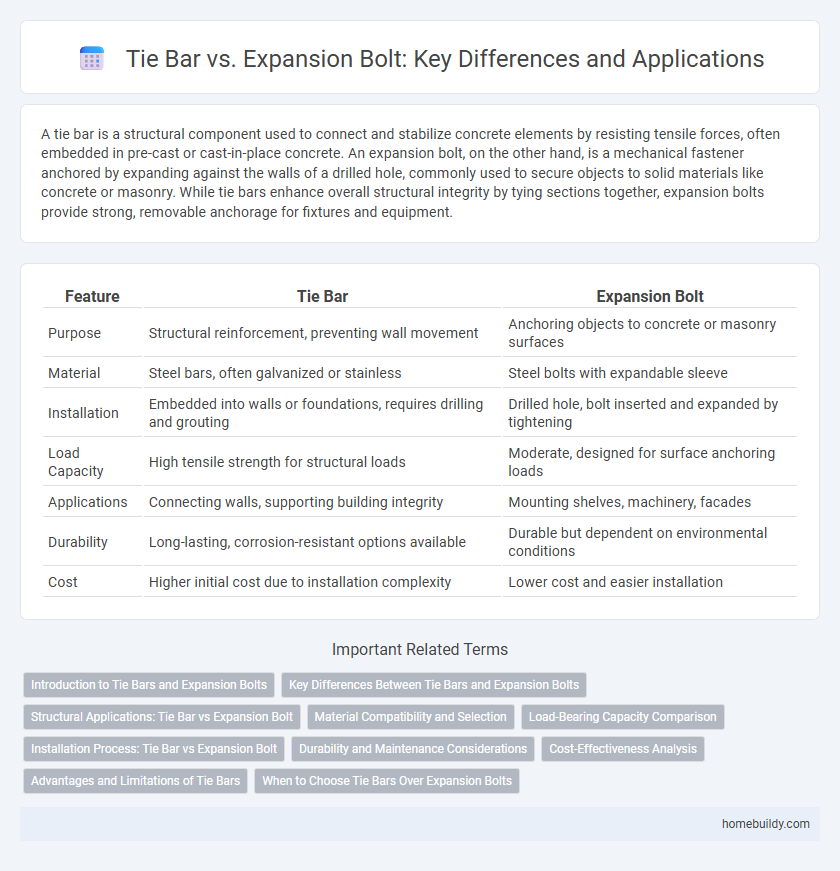A tie bar is a structural component used to connect and stabilize concrete elements by resisting tensile forces, often embedded in pre-cast or cast-in-place concrete. An expansion bolt, on the other hand, is a mechanical fastener anchored by expanding against the walls of a drilled hole, commonly used to secure objects to solid materials like concrete or masonry. While tie bars enhance overall structural integrity by tying sections together, expansion bolts provide strong, removable anchorage for fixtures and equipment.
Table of Comparison
| Feature | Tie Bar | Expansion Bolt |
|---|---|---|
| Purpose | Structural reinforcement, preventing wall movement | Anchoring objects to concrete or masonry surfaces |
| Material | Steel bars, often galvanized or stainless | Steel bolts with expandable sleeve |
| Installation | Embedded into walls or foundations, requires drilling and grouting | Drilled hole, bolt inserted and expanded by tightening |
| Load Capacity | High tensile strength for structural loads | Moderate, designed for surface anchoring loads |
| Applications | Connecting walls, supporting building integrity | Mounting shelves, machinery, facades |
| Durability | Long-lasting, corrosion-resistant options available | Durable but dependent on environmental conditions |
| Cost | Higher initial cost due to installation complexity | Lower cost and easier installation |
Introduction to Tie Bars and Expansion Bolts
Tie bars are steel reinforcements used in concrete construction to hold formwork in place and provide tensile strength, ensuring structural stability in slabs and walls. Expansion bolts are mechanical fasteners that anchor objects to concrete or masonry by expanding within drilled holes, providing strong, vibration-resistant connections. Unlike expansion bolts, tie bars are embedded within the concrete structure to resist tensile forces from within, making them essential for maintaining form alignment during concrete pouring.
Key Differences Between Tie Bars and Expansion Bolts
Tie bars provide tensile reinforcement by connecting concrete slabs or walls to control cracking and structural movement, primarily used in restrained concrete applications. Expansion bolts anchor fixtures into concrete or masonry through mechanical expansion, offering strong load-bearing capacity for structural attachments. While tie bars enhance structural integrity by distributing tensile stress, expansion bolts focus on securing objects to solid surfaces, making their applications and load functions distinctly different.
Structural Applications: Tie Bar vs Expansion Bolt
Tie bars provide superior load distribution in concrete structures by connecting and reinforcing adjacent elements, minimizing stress concentrations and enhancing overall stability. Expansion bolts offer strong anchorage in solid materials but may induce localized stress and are less effective in dynamic or high-vibration environments. For structural applications requiring continuous load transfer and crack control, tie bars outperform expansion bolts in maintaining integrity and durability.
Material Compatibility and Selection
Tie bars typically use high-strength steel, offering superior tensile strength and compatibility with concrete substrates, ideal for structural reinforcement. Expansion bolts often come in stainless steel or carbon steel, chosen based on the environment to prevent corrosion when anchoring into masonry or concrete. Material selection between tie bars and expansion bolts depends on load requirements, environmental conditions, and substrate properties to ensure durability and optimal performance.
Load-Bearing Capacity Comparison
Tie bars offer superior load-bearing capacity compared to expansion bolts due to their deep embedding within concrete elements, which distributes stress more evenly and reduces the risk of pull-out failure. Expansion bolts rely on surface friction and mechanical interlock, often resulting in lower efficiency under dynamic or heavy loads. Structural engineers prioritize tie bars in applications requiring high tensile strength and durability under fluctuating load conditions.
Installation Process: Tie Bar vs Expansion Bolt
The installation process of a tie bar involves drilling aligned holes through concrete or masonry surfaces to anchor and secure structural elements tightly, providing effective crack control and load distribution. In contrast, expansion bolts require drilling a hole slightly smaller than the bolt, inserting the bolt with an expansion sleeve, and tightening it to expand the sleeve, creating a strong mechanical grip within the material. Tie bars typically demand precise alignment and more labor-intensive preparation compared to the faster, simpler installation of expansion bolts, which are preferred for their ease and speed in securing heavy loads.
Durability and Maintenance Considerations
Tie bars typically offer superior durability compared to expansion bolts due to their solid steel construction and resistance to loosening under dynamic loads. Maintenance requirements for tie bars are minimal, often limited to periodic inspections for corrosion or fatigue, whereas expansion bolts may require regular retightening and corrosion protection. The long lifespan and lower upkeep costs of tie bars make them preferable in applications demanding high structural integrity and reliability.
Cost-Effectiveness Analysis
Tie bars typically offer greater cost-effectiveness compared to expansion bolts due to their lower installation and maintenance expenses. Expansion bolts often require specialized tools and more labor-intensive procedures, increasing overall project costs. In large-scale construction, tie bars reduce material waste and improve structural integrity, leading to long-term financial savings.
Advantages and Limitations of Tie Bars
Tie bars provide consistent load distribution and reduce stress concentrations in concrete structures, offering enhanced structural integrity compared to expansion bolts. They perform well under dynamic and cyclic loads but require precise installation and are limited in applications where access is restricted or where adjustments after setting are necessary. While tie bars excel in long-term durability and minimizing cracking, expansion bolts offer quicker installation and easier removability in temporary or less critical fixtures.
When to Choose Tie Bars Over Expansion Bolts
Tie bars are ideal for securing walls or concrete elements when structural integrity under tension is critical, especially in situations involving thermal expansion or ground movement. They provide a more reliable load distribution and reduce the risk of concrete cracking compared to expansion bolts, which are better suited for lighter, non-structural attachments. Choose tie bars when long-term durability and resistance to dynamic forces in concrete construction are required.
Tie bar vs Expansion bolt Infographic

 homebuildy.com
homebuildy.com